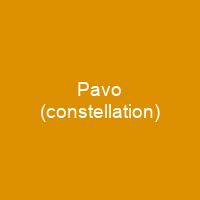Pavo is a constellation in the southern sky whose name is Latin for ‘peacock’ It first appeared on a 35-cm diameter celestial globe published in 1598 in Amsterdam. It contains NGC 6752, the third-brightest globular cluster in the sky. Six of the star systems in Pavo have been found to host planets.
About Pavo (constellation) in brief

The first depiction of this constellation in a celestial atlas was in German cartographer Johann Bayer’s Uranometria of 1603. It is uncertain whether the Dutch astronomers had the Greek mythos in mind when creating Pavo but, in keeping with other constellation introduced by Petrus Plancius through Pieter Dirkszoon Keyser and Frederick de Houtman, the new constellation likely referred to the green peacock, which the Greeks called Argus. The peacock and the “Argus” nomenclature are also prominent in a different myth, in which Io, a beautiful princess of Argos, was lusted after by Zeus. Zeus changed Io into a heifer to deceive his wife Hera and couple with her. As recounted in Ovid’s Metamorphoses, the death of Argus Panoptes also contains an explicit celestial reference: “Argus lay dead; so many eyes, so bright quenched, and all hundred shrouded in one night. Saturnia filled his tail with starry jewels”
You want to know more about Pavo (constellation)?
This page is based on the article Pavo (constellation) published in Wikipedia (as of Nov. 05, 2020) and was automatically summarized using artificial intelligence.







